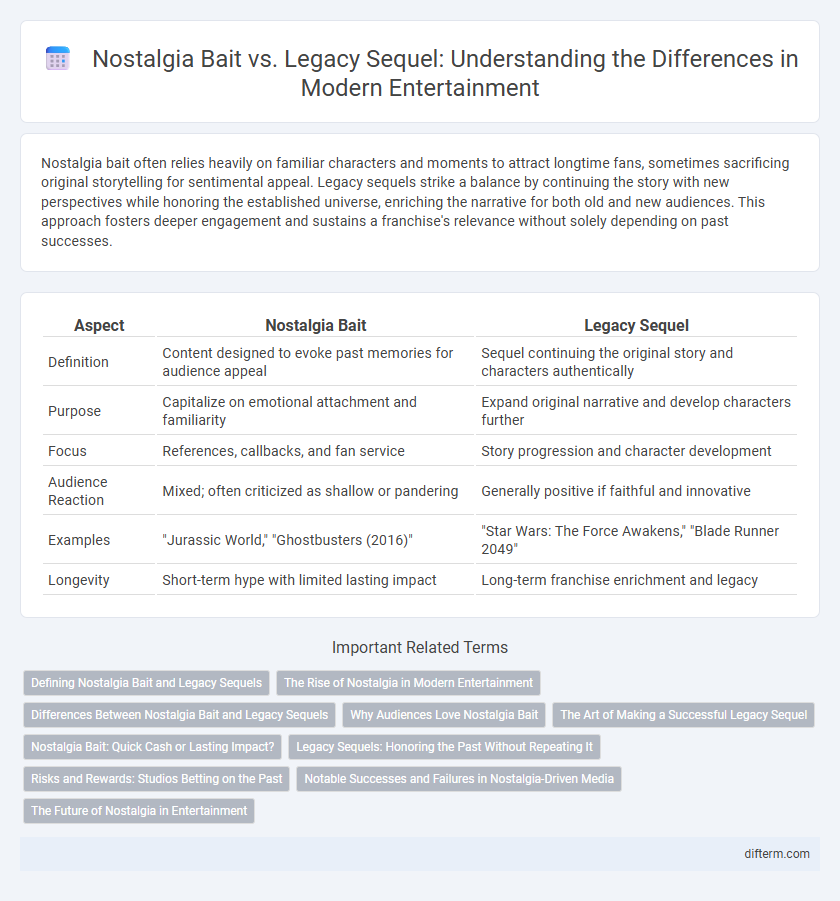Nostalgia bait often relies heavily on familiar characters and moments to attract longtime fans, sometimes sacrificing original storytelling for sentimental appeal. Legacy sequels strike a balance by continuing the story with new perspectives while honoring the established universe, enriching the narrative for both old and new audiences. This approach fosters deeper engagement and sustains a franchise's relevance without solely depending on past successes.
Table of Comparison
| Aspect | Nostalgia Bait | Legacy Sequel |
|---|---|---|
| Definition | Content designed to evoke past memories for audience appeal | Sequel continuing the original story and characters authentically |
| Purpose | Capitalize on emotional attachment and familiarity | Expand original narrative and develop characters further |
| Focus | References, callbacks, and fan service | Story progression and character development |
| Audience Reaction | Mixed; often criticized as shallow or pandering | Generally positive if faithful and innovative |
| Examples | "Jurassic World," "Ghostbusters (2016)" | "Star Wars: The Force Awakens," "Blade Runner 2049" |
| Longevity | Short-term hype with limited lasting impact | Long-term franchise enrichment and legacy |
Defining Nostalgia Bait and Legacy Sequels
Nostalgia bait exploits familiar characters and settings primarily to attract fans with emotional triggers without advancing the story or deepening the original themes. Legacy sequels continue the original narrative or universe by integrating new characters alongside veteran ones, aiming to respect and expand the source material. These approaches differ in intent and execution, with nostalgia bait often criticized for shallow fan service, while legacy sequels seek to balance homage with innovation.
The Rise of Nostalgia in Modern Entertainment
The rise of nostalgia in modern entertainment leverages familiar characters and storylines to evoke emotional connections, boosting audience engagement and box office returns. Nostalgia bait often relies on repetitive callbacks and fanservice, while legacy sequels expand the original narrative to honor past lore and evolve the franchise. Studios increasingly deploy nostalgia-driven projects to capitalize on established franchises, balancing creative innovation with the comfort of recognition.
Differences Between Nostalgia Bait and Legacy Sequels
Nostalgia bait primarily targets longtime fans through repeated references and familiar aesthetics without substantial narrative progression, often relying on emotional triggers rather than new story developments. Legacy sequels, in contrast, continue the original storyline by integrating fresh characters and evolving plotlines, balancing fan service with meaningful expansion of the universe. While nostalgia bait emphasizes homage and recognition, legacy sequels prioritize continuity and growth within the established franchise.
Why Audiences Love Nostalgia Bait
Audiences love nostalgia bait because it taps into their emotional memories by revisiting beloved characters, settings, and storylines from the past, creating a comforting sense of familiarity. This strategic use of nostalgic elements enhances engagement and drives anticipation, often boosting viewership and merchandise sales. Nostalgia bait's appeal lies in its ability to evoke personal experiences while still delivering fresh content within a trusted franchise framework.
The Art of Making a Successful Legacy Sequel
Crafting a successful legacy sequel requires balancing reverence for the original material with fresh storytelling that appeals to both longtime fans and new audiences. Unlike nostalgia bait, which relies heavily on callbacks and fan service, a legacy sequel expands the universe, deepening character development and advancing the plot meaningfully. Films like "Star Wars: The Force Awakens" and "Jurassic World" demonstrate how integrating legacy elements with innovative narratives can sustain franchise vitality and commercial success.
Nostalgia Bait: Quick Cash or Lasting Impact?
Nostalgia bait capitalizes on familiar characters and storylines to generate swift revenue, often sacrificing narrative depth for immediate fan service. Unlike legacy sequels that honor and expand original stories, nostalgia bait tends to prioritize profitable callbacks over meaningful innovation. This approach risks alienating long-time fans seeking authentic continuation and undermines a franchise's potential for lasting cultural impact.
Legacy Sequels: Honoring the Past Without Repeating It
Legacy sequels honor the original storylines and characters by advancing the narrative while preserving core themes and emotional resonance. These films balance nostalgia with innovation, introducing fresh plot elements and contemporary perspectives to engage both returning fans and new audiences. By respecting the source material without merely repeating it, legacy sequels create meaningful continuations that enrich the franchise's legacy.
Risks and Rewards: Studios Betting on the Past
Nostalgia bait often risks alienating audiences with shallow references that prioritize fan service over storytelling, potentially leading to critical backlash and diminished brand value. Legacy sequels leverage established characters and narratives, offering deeper emotional resonance and renewed franchise relevance, but they also face the challenge of balancing innovation with fan expectations. Studios betting on the past must carefully navigate these dynamics to maximize box office returns while preserving long-term franchise integrity.
Notable Successes and Failures in Nostalgia-Driven Media
Nostalgia bait often drives initial audience interest but can falter due to shallow storytelling or overreliance on fan service, exemplified by the mixed reception of "Ghostbusters" (2016). Legacy sequels like "Star Wars: The Force Awakens" succeed by balancing fresh narratives with iconic elements, revitalizing franchises while honoring original fans. Failures in nostalgia-driven media typically stem from ignoring evolving audience expectations, as seen in "Indiana Jones and the Kingdom of the Crystal Skull," which struggled to resonate despite its legacy status.
The Future of Nostalgia in Entertainment
Nostalgia bait leverages familiar characters and storylines to evoke past emotions but often sacrifices narrative depth, while legacy sequels integrate original elements with fresh storytelling to expand a franchise's universe. The future of nostalgia in entertainment lies in balancing homage and innovation, using advanced technology and diverse narratives to enrich audience engagement without relying solely on past success. This evolving approach drives sustainable fan loyalty and revitalizes classic properties for new generations.
nostalgia bait vs legacy sequel Infographic

 difterm.com
difterm.com